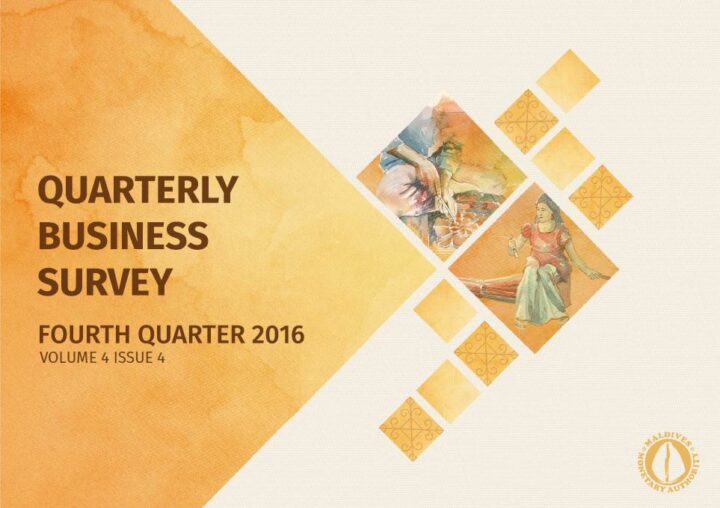
MMA’s Quarterly Business Survey shows positive growth for the Tourism Sector
[vc_row][vc_column][vc_column_text]Tourism Sector
Reflecting the commencement of the peak season for the tourism industry, most respondents from the tourist resorts indicated an increase in total revenue and resort bookings in Q4-2016 compared with the previous quarter―net balances of 88% and 17%, respectively (Figure 4).
Looking at average room rates, 91% of respondents reported an increase in Q4-2016 compared with Q3-2016. As for employment numbers during the period, 75% of respondents indicated that it remained the same while 22% reported an increase.
As for business costs, 71% and 64% of businesses reported no change in labour-related costs and input prices, respectively. During the review quarter, 45% of businesses indicated improvement in their financial situation; recording a net balance of 34%. Meanwhile, 87% of respondents reported no change in access to credit in Q4-2016 over Q3-2016, while 11% reported an increase.[/vc_column_text][/vc_column][/vc_row][vc_row][vc_column][vc_single_image image=”12257″ img_size=”large”][/vc_column][/vc_row][vc_row][vc_column][vc_column_text]Expectations for the next quarter
Looking ahead, most of the businesses in the tourism sector expect total revenue, resort bookings and average room rates to increase in Q1-2017 compared with Q4-2016, as indicated by positive net balances of 70%, 72% and 69%, respectively. Majority of respondents expect the number of employees on the payroll to remain unchanged during Q1-2017 while 18% expect an increase. As for the average room rates, 82% of the respondents expect it to increase in Q1-2017.
Looking at business costs, 56% of the businesses anticipate no change in labour costs while 47% of businesses expect input costs to increase in Q1-2017 compared with Q4-2016 (net balances of 37% and 39%, respectively). With regard to future investment plans, 22% of the respondents plan to increase their capital expenditure in Q1-2017 compared with Q4- 2016 (net balance of 10%). Fifty-three percent of respondents expect their financial situation to improve in Q1-2017 compared with Q4-2016, while 47% of respondents anticipate no change during the same period.
As for access to credit, 87% of businesses expect no change in access to credit in Q1-2017 over Q4-2016 (net balance of 8%).
Factors limiting business growth
In analysing the factors which limit growth opportunities for businesses in the tourism sector, the most significant factor highlighted by the businesses was competition within the sector. Additionally, insufficient demand, cost of labour, limitations in the regulatory framework and shortage of local labour were also reported as some of the constraints (Figure 6)[/vc_column_text][/vc_column][/vc_row][vc_row][vc_column][vc_single_image image=”12258″ img_size=”large”][/vc_column][/vc_row][vc_row][vc_column][vc_column_text]About the survey
The respondents of the business survey are senior managers or top management of businesses who has an overall view of the business situation. The questions cover the views of the senior management (for the past quarter and expectation for the next quarter) on the direction of change in various business variables such as sales, output, prices, exports, capacity utilisation and employment which are useful for analysing and predicting economic activity. The qualitative response for these questions takes the form of either increase, decrease or no change.
The business survey for Q4-2016 was conducted from 22nd December 2016 to 10th January 2017. Survey forms were sent out to 143 large enterprises in the construction; tourism and; wholesale and retail trade sectors. The survey sample is based on information provided by the Maldives Inland Revenue Authority. A total of 88 enterprises responded during the survey period which represents an overall response rate of 62%.
The accounting concept, net balance approach, has been used in converting qualitative responses to quantitative numbers. All responses are weighted based on their relative size within their respective sector. Net balances measure the difference between the percentage of respondents who gave positive responses and the percentage of respondents who gave negative responses.
Care should be taken when interpreting the results of individual sectors as constraints in sample selection limit the representativeness of certain industries within each sector.
The MMA would thanks all the parties who contributed to the survey, especially the survey respondents.[/vc_column_text][/vc_column][/vc_row][vc_row][vc_column][vc_single_image image=”12259″ img_size=”large”][/vc_column][/vc_row]






